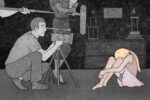In the early ages of cinema, Walt Disney Animation Studios dominated the entertainment industry. Warner Bros. Animation and Fleischer Studios were known for making short slapstick animated films, but Disney focused on musicals. The studio made the first cartoon with synchronized sound, “Steamboat Willie,” in 1928. The short film also marked the debut of Mickey Mouse, who eventually became the studio’s mascot. Disney then made the first full-length animated feature film, “Snow White and the Seven Dwarves,” in 1937. The studio maintained their success for decades until the late 1960s. On December 15, 1966, Walt Disney passed away; the studio’s workers and fans mourned his death. The quality and quantity of the studio’s animated content began to decline. “The Black Cauldron,” which was released in 1985, was a box office bomb. The movie only made $25 million, compared to its $44 million budget. As a result, the company downgraded to a small studio in Glendale. To avoid bankruptcy, they needed a hit.
In 1987, Disney Chairman Jeffrey Katzenberg greenlit a 2D animated adaptation of Hans Christian Anderson’s classic fairy tale, “The Little Mermaid.” Katzenberg intended for the film to be like a Broadway musical, so he hired Howard Ashman to write the score. Ashman’s success with “Little Shop of Horrors” and his contribution to Disney’s “Oliver and Company” gave Katzenberg faith that he could save the studio.
Ashman was under pressure from the studio to make hit songs that would attract all audiences, but especially children. As Ashman began writing the songs, he also changed some of the characters’ personality traits and appearances. For example, he was responsible for making Sebastian, Ariel’s crab sidekick, Jamaican, and he approved the final design of Ursula, the villain. Some of the creative choices that Ashman made, however, were questioned by the studio. Disney wanted to cut the “Part of Your World” sequence because children stopped paying attention during its initial test screening. Ashman persuaded Katzenberg to keep the song, as it is significant to Ariel’s character arc. After two years in development, “The Little Mermaid” was finally released in theaters on November 17, 1989. The film exceeded the studio’s high expectations; not only did critics give it positive reviews, but it also grossed $211 million at the box office. Critics applauded Ashman’s score, which included classics like “Kiss the Girl” and “Under the Sea.” Both songs were nominated for best original song at the Academy Awards the following year, and “Under the Sea” won. The popularity of Ashman’s songs ushered in what would later become known as Disney’s Renaissance era. The films that were released in this era include “Beauty and the Beast,” “Aladdin,” “The Lion King,” “Hercules” and “Mulan.” Without Ashman’s storytelling and songwriting expertise, the studio wouldn’t have redeemed its reputation for making high-quality animated features.
Ashman was born in Baltimore, Maryland on May 17, 1950. He studied theater at Boston University and later received a master’s degree in fine arts from Indiana University. After he graduated in 1974, Ashman moved to New York with his partner to pursue their dream of becoming playwrights.
As he settled into the city, he got a job as a copy editor for the Mickey Mouse Clubhouse scrapbook. Even though Ashman loved the job, he still wanted to write plays. He wrote his first two plays, “Cause Maggie’s Afraid of the Dark” and “Dreamstuff” during this time. Despite receiving mixed reviews from audiences, Ashman didn’t stop pursuing his dream. In 1977, he became the artistic director of the Workshop of the Players Art Foundation (WPA) theater in New York City. He also met his future collaborator Alan Menken at the Broadcast Music, Inc. theater workshop. In 1979, they made their first musical together, called “Kurt Vonnegut’s God Bless You, Mr. Rosewater.” However, they didn’t receive mainstream attention until they collaborated on “Little Shop of Horrors.” When Ashman first approached his colleagues with the idea of adapting the project for musical theater, they initially told him it would be too cheesy and odd. Ashman didn’t care and moved forward with his vision. On May 6, 1982, the musical premiered at the WPA theater to overwhelmingly positive reviews. The show won a Drama Desk Award for “Outstanding Musical” and was nominated for best musical theatre album at the Grammys.
After “Little Shop of Horrors,” Ashman went on to adapt “Smile” for the stage. Ashman met Jodi Benson while working on the show; he later asked her to audition for the role of Ariel in “The Little Mermaid.” Though “Smile” was nominated for best book of a musical at the Tony Awards, it received negative reviews from critics. Luckily, Disney came in at the right time and provided him the opportunity to work on “The Little Mermaid.” During the production of “The Little Mermaid,” Ashman was diagnosed with AIDS. However, he continued to work.
After completing “The Little Mermaid,” Ashman proceeded to write songs for the next installment in the Disney Renaissance, “Beauty and the Beast.” He worked alongside Menken once again to write songs for the film. Meanwhile, they were simultaneously developing another fairy tale adaptation, “Aladdin.”
Ashman worked on all these projects despite his progressing AIDS symptoms. He couldn’t travel to Los Angeles to work on the film, so the company moved the entire production to an empty studio near Ashman to allow him to complete it. The effects of AIDS weakened him over time, and he had to permanently move to the hospital. Nevertheless, this didn’t stop him from working for Disney. Menken recalls that they wrote “Prince Ali” on Ashman’s hospital bed. Eight months before Disney released “Beauty and the Beast,” Ashman passed away on March 14, 1991. Though he never saw the completed version of “Beauty and the Beast,” the studio showed him a rough cut of the film before his death. “Beauty and the Beast” was eventually nominated for five Academy Awards including best picture, making it the first animated film to ever achieve this honor. Two years after Ashman’s death, he was also nominated for his work on the song “Friend Like Me” from Aladdin, in the category best original song.
Ashman’s legacy still lives on today. Disney’s theme parks have brought Ashman’s characters to life; fans can meet their favorite characters and sing with them to Ashman’s beloved songs. The company has also been remaking these animated films into live-action movies. Disney’s latest live-action movie is a remake of Ashman’s first film for the company, “The Little Mermaid.” Ashman’s contributions to Disney’s legacy remain iconic. He will always be remembered as a legend in musical theater, and his work continues to define the childhoods of generations to come.

















